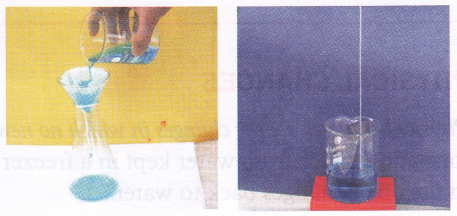What are the Physical Changes of a Substance
Physical changes
Physical changes are the changes in which no new substances are formed. For example, the formation of ice from water kept in a freezer is a physical change because the ice when kept in the open changes back to water.
In most of the physical changes, properties such as colour, shape, size, or physical form of the substance may change. Physical changes may or may not be reversible. An example of physical change is discussed below.
Crystallization
Crystals are the purest solid form of a substance having a definite geometrical shape. The process by which an impure compound is converted into its crystals is known as crystallization.
This process is used in obtaining common salt from seawater.
Let us take common salt as an example. Chemically, common or table salt is sodium chloride (NaCl). Common salt is obtained by evaporating sea water. The salt, thus obtained, contains certain undesirable substances such as magnesium chloride, sand, etc., mixed with sodium chloride. These impurities are removed from common salt through the process of crystallization.

In crystallization, maximum amount of common salt is dissolved in boiling water. The solution is then filtered to remove the insoluble impurities. The filtered solution is left undisturbed for a few hours. Sodium chloride will aggregate and form crystals with well- defined geometrical shapes, leaving behind the undesirable impurities in the solution.
Activity
Aim: To prepare crystals of copper sulphate from an impure sample of copper sulphate
Materials needed: A beaker, distilled water, powdered copper sulphate, stirrer, and sulphuric acid
Method:
1. Take a beaker and fill it half with distilled water. Now keep on adding powdered copper sulphate into the water with constant stirring till no more of it dissolves.
2. Add half a test tube of sulphuric acid to it.

3. Start heating and again add copper sulphate till a saturated solution is produced.
4. Filter the hot solution immediately to remove insoluble impurities and keep the saturated solution of copper sulphate undisturbed for a few hours.
Observation: Well-shaped crystals of copper sulphate are formed.